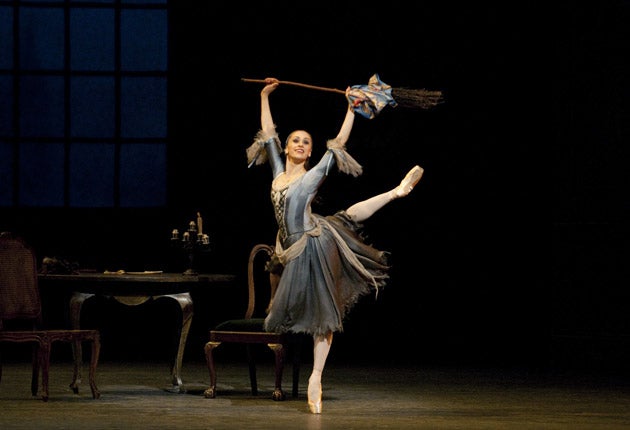Cinderella, Royal Opera House, London
Classic tale could do with a polish

Your support helps us to tell the story
From reproductive rights to climate change to Big Tech, The Independent is on the ground when the story is developing. Whether it's investigating the financials of Elon Musk's pro-Trump PAC or producing our latest documentary, 'The A Word', which shines a light on the American women fighting for reproductive rights, we know how important it is to parse out the facts from the messaging.
At such a critical moment in US history, we need reporters on the ground. Your donation allows us to keep sending journalists to speak to both sides of the story.
The Independent is trusted by Americans across the entire political spectrum. And unlike many other quality news outlets, we choose not to lock Americans out of our reporting and analysis with paywalls. We believe quality journalism should be available to everyone, paid for by those who can afford it.
Your support makes all the difference.As midnight strikes, the ballroom dancers in Frederick Ashton's Cinderella start to move like clockwork.
Prokofiev's music evokes a menacing grinding of cogs as the dancers block Cinderella's way. Their arms swing mechanically, their feet driving the stroke of midnight home. In this Royal Ballet revival, blunted dancing softens the point. It all becomes more polite, less emphatic, less powerful.
That's characteristic of Wendy Ellis Somes's production. It's a fusspot Cinderella, from the introduction of fiddly detail to the airless, cartoony scenery by Toer van Schayk. This revival is tighter than the last, with some improvement in pacing. It still needs more energy and crisper style.
Birmingham Royal Ballet has recently finished dancing David Bintley's production of Cinderella in the capital. Ashton's individual dances are stronger than Bintley's, but the Birmingham production has much swifter pacing and superb designs. The Royal Ballet Cinderella is weighed down by Van Schayk and by Christine Haworth's ugly layered costumes.
Pacing has always been a challenge with Ashton's Cinderella. It has large shifts in tone, from the clowning of the Ugly Sisters, played by men, to the spiky, dreamy dances of the ballroom and fairy scenes. The music isn't a sweet fairytale; it's full of sharp edges and dark undertones, qualities that Ashton catches in the dancing. The entrance of the corps de ballet of stars can still be thrilling: they leap on in springy, sharp jumps, even if the dancing quality could be more pointed.
Marianela Nuñez, a naturally sunny performer, builds that quality into her Cinderella. Her heroine tries to look on the bright side. She can't join in her sisters' dancing lesson, but dances along in the background. When she looks down sadly at her rags, she automatically brushes away the dirt, making the best of things.
On the first night, her dancing had less sweep than usual. She was tense in the ballroom solo, moving on a smaller scale through its delicate balances and whipping turns. Back in the kitchen, she dances with more abandon, remembering with more glee. She was stronger in her duets with Thiago Soares' Prince, with a sense of snuggling into his arms. Soares forces his dancing: he seems to push himself into turns, heaving himself into the air.
Laura Morera, as the Fairy Godmother, dances with warm precision. She brings out the upper-body delicacy of these dances, with a protective tenderness towards the heroine. The Season fairies were strongly cast, but the dances have not been well coached. Emma Maguire catches some of the sheer bounce of Spring, and Yuhui Choe's Summer is languidly elegant. Akane Takada's speed should make her a fine Autumn, but she's far too upright: the risky, off-balance quality of the solo has gone missing. Hikaru Kobayashi struggles with the frosty grandeur of the Winter solo.
The Ugly Sisters take up a great deal of Ashton's ballet. Jonathan Howells and Alastair Marriott are a good pair, their bickering precisely observed.
In rep to 6 May (020 7304 4000)
Join our commenting forum
Join thought-provoking conversations, follow other Independent readers and see their replies
Comments